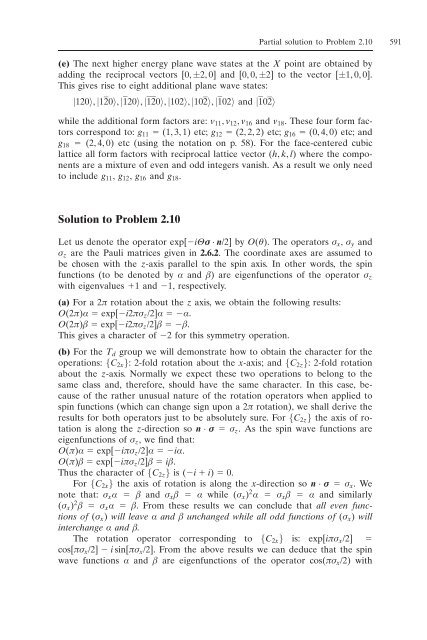10. Appendix
You also want an ePaper? Increase the reach of your titles
YUMPU automatically turns print PDFs into web optimized ePapers that Google loves.
Partial solution to Problem 2.10 591<br />
(e) The next higher energy plane wave states at the X point are obtained by<br />
adding the reciprocal vectors [0, ±2, 0] and [0, 0, ±2] to the vector [±1, 0, 0].<br />
This gives rise to eight additional plane wave states:<br />
|120〉, |120〉, |120〉, |120〉, |102〉, |102〉, |102〉 and |102〉<br />
while the additional form factors are: v11, v12, v16 and v18. These four form factors<br />
correspond to: g11 (1, 3, 1) etc; g12 (2, 2, 2) etc; g16 (0, 4, 0) etc; and<br />
g18 (2, 4, 0) etc (using the notation on p. 58). For the face-centered cubic<br />
lattice all form factors with reciprocal lattice vector (h, k, l) where the components<br />
are a mixture of even and odd integers vanish. As a result we only need<br />
to include g11, g12, g16 and g18.<br />
Solution to Problem 2.10<br />
Let us denote the operator exp[i£Û · n/2] by O(ı). The operators Ûx, Ûy and<br />
Ûz are the Pauli matrices given in 2.6.2. The coordinate axes are assumed to<br />
be chosen with the z-axis parallel to the spin axis. In other words, the spin<br />
functions (to be denoted by · and ‚) are eigenfunctions of the operator Ûz<br />
with eigenvalues 1 and 1, respectively.<br />
(a) For a 2apple rotation about the z axis, we obtain the following results:<br />
O(2apple)· exp[i2appleÛz/2]· ·.<br />
O(2apple)‚ exp[i2appleÛz/2]‚ ‚.<br />
This gives a character of 2 for this symmetry operation.<br />
(b) For the Td group we will demonstrate how to obtain the character for the<br />
operations: {C2x}: 2-fold rotation about the x-axis; and {C2z}: 2-fold rotation<br />
about the z-axis. Normally we expect these two operations to belong to the<br />
same class and, therefore, should have the same character. In this case, because<br />
of the rather unusual nature of the rotation operators when applied to<br />
spin functions (which can change sign upon a 2apple rotation), we shall derive the<br />
results for both operators just to be absolutely sure. For {C2z} the axis of rotation<br />
is along the z-direction so n · Û Ûz. As the spin wave functions are<br />
eigenfunctions of Ûz, we find that:<br />
O(apple)· exp[iappleÛz/2]· i·.<br />
O(apple)‚ exp[iappleÛz/2]‚ i‚.<br />
Thus the character of {C2z} is (i i) 0.<br />
For {C2x} the axis of rotation is along the x-direction so n · Û Ûx. We<br />
note that: Ûx· ‚ and Ûx‚ · while (Ûx) 2 · Ûx‚ · and similarly<br />
(Ûx) 2 ‚ Ûx· ‚. From these results we can conclude that all even functions<br />
of (Ûx) will leave · and ‚ unchanged while all odd functions of (Ûx) will<br />
interchange · and ‚.<br />
The rotation operator corresponding to {C2x} is: exp[iappleÛx/2] <br />
cos[appleÛx/2] i sin[appleÛx/2]. From the above results we can deduce that the spin<br />
wave functions · and ‚ are eigenfunctions of the operator cos(appleÛx/2) with










